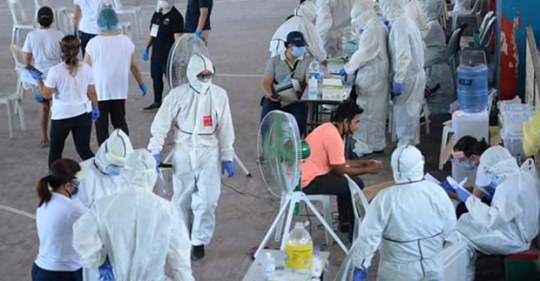Rise in COVID-19 cases in regions linked to returnees
Recent cases of the new coronavirus disease (COVID-19) in the Visayas involved returning overseas Filipino workers (OFWs) and residents stranded elsewhere, raising concerns that those being sent home to the provinces were carriers of the virus.
In Western Visayas, the Department of Health (DOH) reported nine new cases involving seven OFWs and two stranded residents from June 13 to June 14. All of them were taken to quarantines in the region.
The DOH also reported that as of June 14, 146 cases had been recorded in the region, including 100 recoveries and 11 deaths. Of the 146 cases, 66 were OFWs and stranded residents returning from Metro Manila and Cebu City.
Health protocols
Under health protocols, OFWs and stranded residents should test negative for COVID-19 and undergo the mandatory 14-day quarantine period before they are allowed to return to their home provinces.National Task Force-COVID-19 chief implementer, Carlito Galvez Jr., confirmed that the return of stranded residents had added to the number of COVID-19 cases in the provinces. He cited the 66 cases in Eastern Visayas and 30 new cases in Lanao del Sur province.
Presidential spokesperson Harry Roque said in a television interview that the government had been caught off-guard by the returning residents and had been unable to prepare for them, unlike in the case of repatriated OFWs.‘Balik Probinsya’
In Leyte province, most of its 135 COVID-19 cases involved returning residents and overseas workers.
Gov. Leopoldo Dominico Petilla, however, said the national government should not be blamed for the surge of cases following the implementation of the “Balik Probinsya” program.
Leyte was among the first provinces to implement the program, which was intended to bring those working and living in Metro Manila back to their home provinces to restart their lives and decongest the capital region.
Petilla, however, said that even those not identified under the program had started to return.
In Negros Occidental, Gov. Eugenio Jose Lacson also attributed the rise of COVID-19 cases in the province to the recent influx of repatriated OFWs and returning residents. As of June 14, Negros Occidental and Bacolod City recorded 22 cases each.
Second wave
In Baguio City, the local government is bracing for what appears to be a second wave of COVID-19 transmissions in the Cordillera after a spike of cases from 57 to 101 in a few days.
Mountain Province, which had no case since the March lockdown, on Tuesday recorded its first transmission involving a resident from Besao town.
“If the trend continues, before the end of this month, Cordillera could deal with 200 cases,” said Baguio Mayor Benjamin Magalong during a management committee meeting.
As a result, Baguio may put on hold a plan to reopen the city to tourists by September should a new wave of infections occur, he said.
Baguio had nine active cases, including a 10-year-old girl and a health worker who contracted the virus from infected patients.
Provinces like Kalinga were initially spared from the virus, but six patients were already recorded there, while neighboring Apayao had seven cases as of Tuesday, according to the DOH. Benguet had the largest number of patients at 21. —REPORTS FROM NESTOR BURGOS JR., JOEY GABIETA, CARLA GOMEZ, VINCENT CABREZA AND LEILA SALAVERRIA INQ
Disclaimer: The comments uploaded on this site do not necessarily represent or reflect the views of management and owner of Cebudailynews. We reserve the right to exclude comments that we deem to be inconsistent with our editorial standards.

